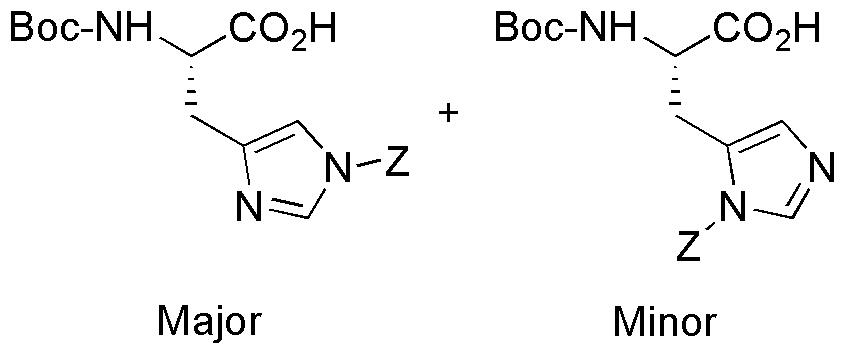Na-Boc-Nim-Z-L-histidine is widely utilized in research focused on:
- Peptide Synthesis: This compound serves as a protective group in the synthesis of peptides, allowing for selective reactions and improving yield. Its stability under various conditions makes it a preferred choice for researchers in organic chemistry.
- Drug Development: In pharmaceutical research, it is used to create histidine derivatives that can enhance drug efficacy. By modifying histidine, researchers can develop new therapeutic agents targeting specific diseases.
- Bioconjugation: The compound is valuable in bioconjugation processes, where it aids in attaching biomolecules to surfaces or other molecules. This application is crucial in developing targeted drug delivery systems.
- Protein Engineering: It plays a significant role in protein engineering, where it is used to modify histidine residues in proteins, improving their stability and functionality for various applications in biotechnology.
- Research in Catalysis: The compound is also explored in catalytic processes, particularly in asymmetric synthesis. Its unique structure can facilitate reactions that are essential in creating complex organic molecules.
Informations générales
Propriétés
Sécurité et réglementation
Applications
Na-Boc-Nim-Z-L-histidine is widely utilized in research focused on:
- Peptide Synthesis: This compound serves as a protective group in the synthesis of peptides, allowing for selective reactions and improving yield. Its stability under various conditions makes it a preferred choice for researchers in organic chemistry.
- Drug Development: In pharmaceutical research, it is used to create histidine derivatives that can enhance drug efficacy. By modifying histidine, researchers can develop new therapeutic agents targeting specific diseases.
- Bioconjugation: The compound is valuable in bioconjugation processes, where it aids in attaching biomolecules to surfaces or other molecules. This application is crucial in developing targeted drug delivery systems.
- Protein Engineering: It plays a significant role in protein engineering, where it is used to modify histidine residues in proteins, improving their stability and functionality for various applications in biotechnology.
- Research in Catalysis: The compound is also explored in catalytic processes, particularly in asymmetric synthesis. Its unique structure can facilitate reactions that are essential in creating complex organic molecules.
Documents
Fiches de données de sécurité (FDS)
La FDS fournit des informations de sécurité complètes sur la manipulation, le stockage et l’élimination du produit.
Spécifications du produit (PS)
Le PS fournit une description complète des propriétés du produit, notamment sa composition chimique, son état physique, sa pureté et les exigences de stockage. Il détaille également les plages de qualité acceptables et les applications prévues du produit.
Certificats d'analyse (COA)
Recherchez des certificats d'analyse (COA) en saisissant le numéro de lot du produit. Les numéros de lot et de lot se trouvent sur l'étiquette d'un produit, après les mots « Lot » ou « Lot de fabrication ».
Numéro de catalogue
Numéro de lot/série
Certificats d'origine (COO)
Ce certificat d'exploitation confirme le pays dans lequel le produit a été fabriqué, et détaille également les matériaux et composants utilisés et s'il est issu de sources naturelles, synthétiques ou autres sources spécifiques. Ce certificat peut être requis pour les douanes, le commerce et la conformité réglementaire.
Numéro de catalogue
Numéro de lot/série
Fiches de données de sécurité (FDS)
La FDS fournit des informations de sécurité complètes sur la manipulation, le stockage et l’élimination du produit.
DownloadSpécifications du produit (PS)
Le PS fournit une description complète des propriétés du produit, notamment sa composition chimique, son état physique, sa pureté et les exigences de stockage. Il détaille également les plages de qualité acceptables et les applications prévues du produit.
DownloadCertificats d'analyse (COA)
Recherchez des certificats d'analyse (COA) en saisissant le numéro de lot du produit. Les numéros de lot et de lot se trouvent sur l'étiquette d'un produit, après les mots « Lot » ou « Lot de fabrication ».
Numéro de catalogue
Numéro de lot/série
Certificats d'origine (COO)
Ce certificat d'exploitation confirme le pays dans lequel le produit a été fabriqué, et détaille également les matériaux et composants utilisés et s'il est issu de sources naturelles, synthétiques ou autres sources spécifiques. Ce certificat peut être requis pour les douanes, le commerce et la conformité réglementaire.

